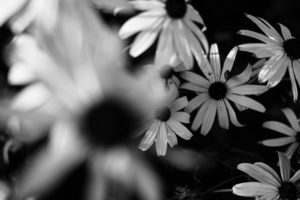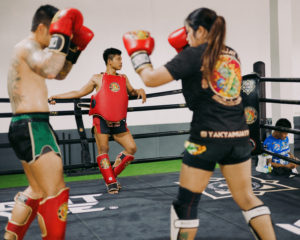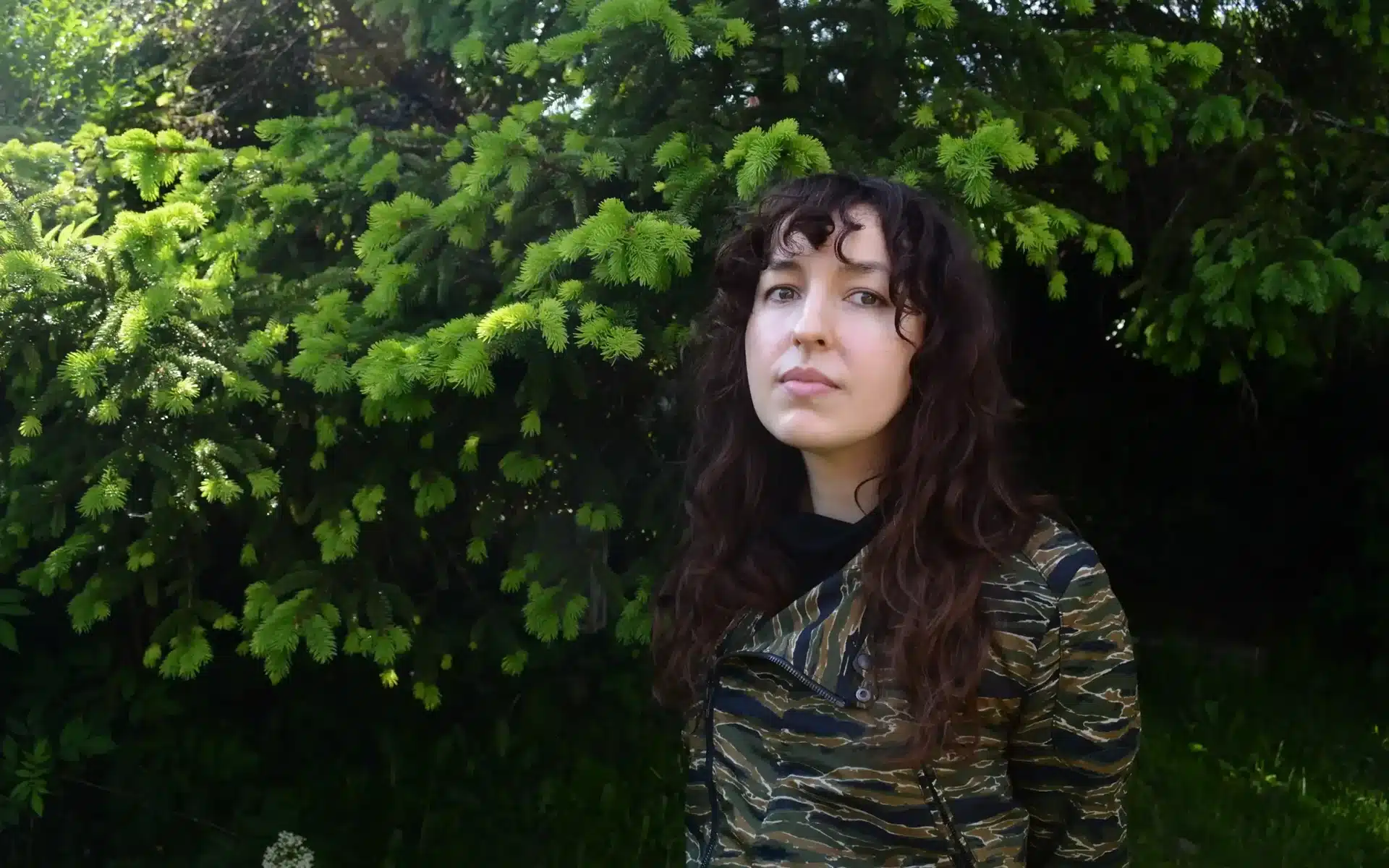By Zoë Goetzmann
Discovering Artistic Inspiration: Interview with Katya Ilina
This week on Cosimo Studio Tours, we traveled to Wembley to visit artist and photographer, Katya Ilina (in her lovely backyard garden turned studio on a gorgeous, rare sunny London day).
Katya is a London artist working in the portrait, fashion and observational photography genres and landscapes. Her artistic practice explores themes related to identity and gender expression. Informed by Katya’s own multicultural perspective, she is inspired by, “the human condition,” as she writes in her own artistic statement, “in the context of social and cultural change.”
In this interview, we delve into Katya’s artistic journey, her photography practice, how she uses photography to tell an artistic narrative, “imposter syndrome,” as well as the importance of an artistic community. We also speak about two of Katya’s projects – one focusing on her travels photographing female Muay Thai fighters in Thailand.
Katya studied Photography at Toronto Metropolitan University (formerly Ryerson University) and the University of Westminster. She also studied Business of Entertainment and Management in the UCLA Extension (which we speak about a bit on in this podcast interview). Her works have been featured in and by the BBC, The Guardian, Creative Review, The Royal Photographic Society Journal, PhMuseum.
Her selected commissions include: Dazed and WeTransfer. She has exhibited globally at the International Photography Exhibition 163, The Royal Photographic Society (Bristol, UK) in 2022, Taylor Wessing Photographic Portrait Prize, The National Portrait Gallery), Cromwell Place (London, UK) in 2023, Full, Seoul Creators Series, Vofol Art Gallery (South Korea) in 2019 and Empty, Seoul Creators Series, Vofol Art Gallery (South Korea) in 2018.
Listen to the full podcast here.

Zoë: So, the first question we like to ask is about your artist’s story. Tell us how you became an artist. What led you to this creative journey?
Katya: It was a long road. Initially, I pursued a marketing business degree based on my parents’ wishes, but photography, film, and art were always my hobbies.
I spent my free time attending exhibitions, watching old films—anything that interested me. This went on for about seven or eight years. Then, while living in Los Angeles and being surrounded by musicians and artists, I felt inspired to make photography and art my main focus.
Spending time with creative people I enjoyed being around made it clear that pursuing a career in the arts was the right choice for me.
Zoë: I didn’t know about your time in Los Angeles. What was that experience like, living and working there compared to the creative atmosphere in London? Do you have any memorable or funny experiences from the artistic landscapes in both cities?
Katya: Well, the first time I lived in London was in 2013, 2014. That’s when I was working in marketing, and most of my friend circles were just people with regular office jobs.
So, it was quite a simple way of life. Most people who work in offices just go to work and maybe go to museums on weekends.
After London, I moved to LA to study film at UCLA Extension, and I started the film business there.
My dream at the time was to work in the film business, and the course at UCLA was probably the best in the world, teaching practical skills.
Zoë: I think that was amazing. We had another artist, Anya, talking about how mythology influenced her.
So, what sort of influences do you draw from? Can you mention films as well? Are there any inspiring films that inform your work and your style, and how you perceive your subjects?
Katya: I actually have a folder on my computer with screenshots I’ve taken over the years while watching movies.
It has been instrumental in helping me understand the things that interest me, such as fonts. In 2021, when I was researching for a project, I realized I was attracted to stories that challenge gender norms for both men and women.
Nowadays, there are many films that address these stories. For example, one film that stood out to me last year was “Our Flag Means Death.” It’s a comedy series by Taika Waititi, where he plays one of the main characters, but the American screenwriter whose name I forgot is the one who wrote it.
The story revolves around gay pirates, challenging the gender norms associated with pirates and how men interact on the ship. It was not only visually inspiring but also a captivating story about humanity.

Zoë: Photography and film offer different visual mediums for storytelling, allowing for various perspectives on gender expression.
I’m curious if your background in film serves as a guiding influence in your practice. Do you have any other artistic influences, whether in the fine art or traditional art world?
Katya: Absolutely. There are many great cinematographers I admire, like Roger Deakins and Christopher Doyle.
I have a whole folder dedicated to incredibly beautiful shots from their movies. One film that comes to mind is “Happy Together” from 1997, directed by Wong Kar-wai. It’s a gay love story about two Chinese immigrants living in Buenos Aires.
The film explores the complexities of their relationship, self-discovery, and searching for identity in a foreign land. The visuals created by the cinematographer are stunning, perfectly capturing the essence of the story.
Zoë: Apart from film, do you express these concepts of gender expression and identity in your work? How do you convey them visually?
Katya: Body language and communication between myself and the model play a significant role in conveying these concepts.
I always collaborate with people who share the same values and perspectives on gender roles, including makeup artists and stylists. Together, we work on conveying the message through clothing, makeup, and overall appearance. It’s a combination of various elements.
Additionally, I often choose non-professional models, which brings a different dimension to the photographs.
Zoë: Does working with non-professional models make the process more natural and spontaneous?
Katya: Yes, exactly. It brings out a more spontaneous side. Professional models sometimes have a set number of poses they rely on, which they have used repeatedly in commercial shoots.
When someone is accustomed to doing things a certain way, it’s harder for them to model differently. Non-models, just like non-actresses in films, behave more naturally, with less self-awareness.
This lack of self-awareness often leads to the most genuine and authentic performances.

Zoë: Are there any specific shoots or natural shoots that come to mind from projects you’ve worked on that you can describe exemplifying this?
Katya: Well, besides the 2021 project, another major one that I’m still in the process of finishing is a documentary project I did in Thailand in February and March of this year.
It focused on female Muay Thai fighters. I’ve been a big fan of Muay Thai for years, and I even practiced it for two years during my time in Canada.
Through my coach there, I was introduced to someone in Thailand who could connect me to the Muay Thai community.
So I traveled to Thailand and photographed female fighters. The project involved both documentary and documentary portrait photography.
I initially visited a gym owned by a female professional fighter from the United States with Filipino origins.
The gym had a multicultural team with members from different backgrounds, including Vietnamese, American, and students from various countries. I documented their training sessions in a documentary style.
Through them, I was introduced to an older gym known for its female fighters. At this gym, I met fighters from Morocco, France, Switzerland, Brazil, and many other places. It was a fascinating and diverse experience meeting these fighters from around the world.
Muay Thai is a type of kickboxing known as the “art of eight limbs” because it incorporates punches, kicks, knees, and elbows.
It originated in Thailand in the 13th century as a martial art practiced by the army.
Due to centuries of conflicts with the Cambodian kingdom, it became deeply ingrained in Thai culture.
Today, Muay Thai is popular worldwide, and Phuket, where I visited, is a hub for international fighters who come to train and improve their skills. Some fighters stay in Phuket for months or even years, training and then traveling to participate in international competitions.
In this project, my aim was to showcase inspiring women athletes who engage in a sport not typically associated with women in sports.
When people think of martial arts, they often think of male fighters like McGregor.
I wanted to highlight the dedication and strength of these female fighters and challenge gender stereotypes. It was a personal motivation for me as well, as I felt inspired to be more disciplined and focused after meeting these incredible individuals.

Zoë: So I guess as another final question, what do you love about photography and the stories you can tell through it, especially when combining it with digital elements and working in this landscape?
Katya: In addition to telling specific stories that personally inspire me, I love the beauty of photography itself.
I was initially drawn to fine art because of its formal characteristics. I find it interesting to appreciate art without knowing the context, and I also enjoy conceptual artworks that are like puzzles, where you have to delve deeper to find references.
As a viewer, I enjoy looking at art, and as an artist, I like creating those puzzles. I hope that people who view my work can spot different references and elements incorporated into the visuals.
Zoë: And what do you like about adding the digital aspect to your work? We’re entering a new digital landscape, so it would be interesting to hear your thoughts on that.
Katya: I think the digital aspect makes art more accessible. It allows you to do things that may not be physically possible or affordable otherwise.
For example, you can create a large photo studio with extensive set design using a computer, and it may even look better or different than the real thing.
AI technology also enables people to create visual content without needing a lot of resources. It opens doors for individuals who couldn’t afford to hire a crew or spend significant time producing, allowing them to tell their stories in digital ways.
Zoë: That’s very helpful. I think what you said about digital art being accessible is important.
People may fear it because it’s a new form, but it allows creators from different fields to enter the traditional landscape and bridge gaps – at Cosimo we’re all about breaking down barriers so that’s great.
Thanks so much for speaking with us today!
Katya: Thank you!









